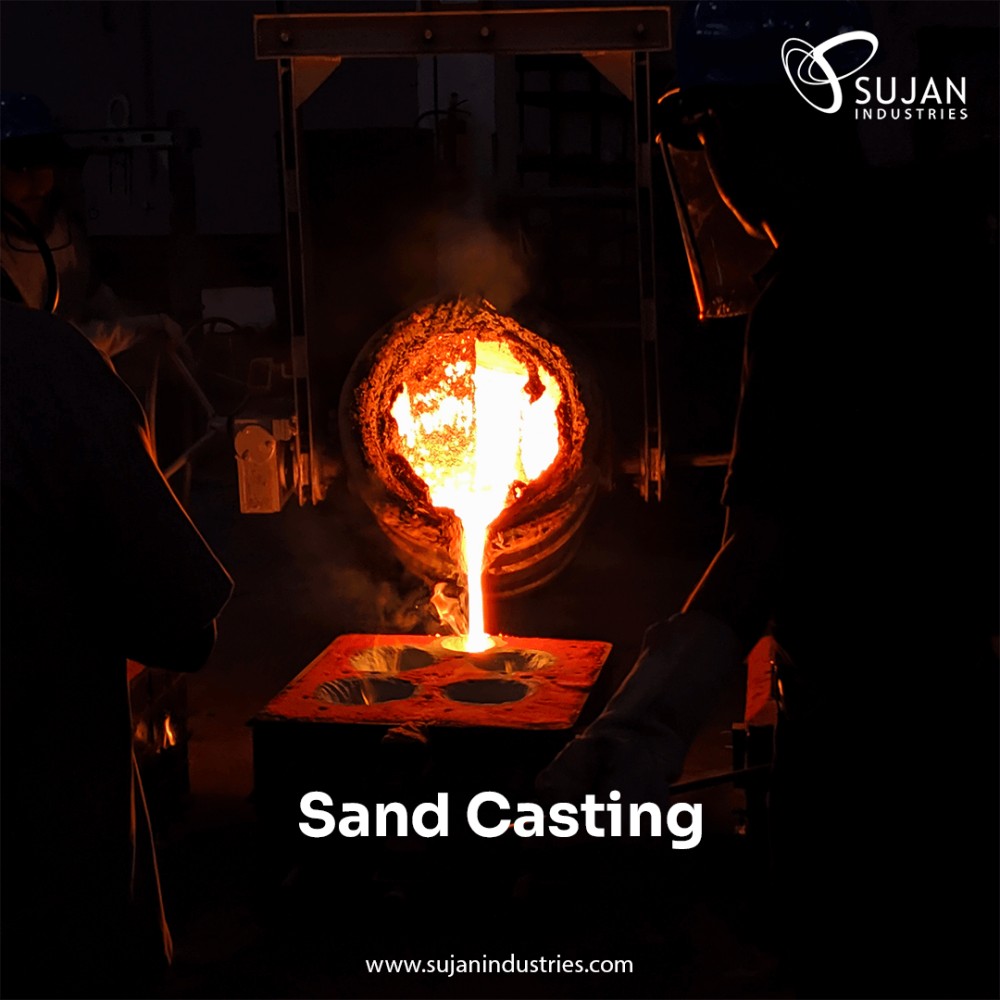
Sand casting is also known as a sand moulded casting, is a process of casting in which sand is used to craft a mould and then liquid metal is poured into that mould to give shape to a part. The casting is used to create metal components of every size, shape, and scale. Almost all metal alloys can be sand cast. However, hollows are created in wet sand, filled with molten metal and then it is left to cool down. Clean sand breaks apart easily, but moulding sand contains bonding material that increases its ability to resist heat and hold shape.
Hence, it is one of the most widely-used casting methods.
We’ll walk through all the steps involved in the sand moulding casting process and illustrate how the entire method is executed.
Sand casting is used to develop metal components and products in a variety of shapes and sizes. Here are the 6 primary steps of the sand mould casting process:
1. Placing of mould pattern in the sand: This is the very first step. Here the mould pattern is placed in the sand. These patterns are often made from wooden or plastic material. The shape and the size of the casting are influenced by the mould. Hence, manufacturing foundries must develop new moulds to develop metal products and components in particular shapes and sizes.
2. Form the gating system : Like most other casting processes, sand moulding casting also includes the use of a gating system. The multiple locations where molten metal is poured into the mould cavity from the runners are called gates. Having a pouring cup and “gates” or tunnels to the mould, the casting is used to channelize the molten metal into the mould cavity. Built-up gases & displaced air escape through vents.
3. Removal of the mould pattern: After the gating system is set up, casting foundries then removes the mould pattern from the sand. At this point, the mould pattern is no more relevant. So when the mould pattern is placed inside the sand, the sand automatically takes the shape of the mould pattern. That being the case, the mould pattern can now be removed.
4. Pouring of the molten metal into the mould cavity: Now it’s time to pour the molten metal into the mould cavity. Sand mould casting supports a wide range of metals and alloys like steel, iron, aluminium, magnesium, zinc etc. Once the alloy or metal turns from a solid to liquid form, they pour it into the mould cavity.
5. Wait for the metal to cool: After the molten metal is poured into the mould cavity, foundries must wait for it to cool down. However, the cooling time for different types of metals is different. So as the molten metal is cooled down, it will come back from a liquid form to a solid form.
6. Removal of the casting from mould& Finishing: The final step involves separating the open mould and taking the newly developed rough metal casting out. The surface of casting can be polished to the required finish. Then after the cleaning, each part needs to inspect and test for defects to ensure compliance with the required quality standards, so that they will perform well in their respective applications.
Some of the moulding sand properties are:
Strength: It’s the ability of the sand mould to hold its geometric shape under any mechanically stressful conditions.
Permeability: It’s the ability of a sand mould to allow the escape of steam and gases during the process of casting.
Moisture content: It impacts the strength and permeability of a mould. Too little moisture in a mould might break it apart while too much moisture can cause steam bubbles to be captured in the casting.
Flowability: It’s the capacity of the sand to fill small cavities in the pattern. The high ability to flow develops a more exact mould, and it is, therefore, useful for more detailed castings.
Grain size: It’s the size of the individual sand particles.
Grain shape: This feature checks the shape of the individual grains of sand based on the shape, like how round they are.
Collapsibility: It’s the capacity of the sand mixture to collapse under heavy force. More mould collapsibility lets the metal casting shrink freely as it solidifies, without the risk of cracking or hot tearing.
Refractory strength: As the molten metal is poured into the mould, it must not crack or melt or burn. Refractory strength evaluates the ability of moulding sand to bear extreme temperatures.
Reusability: It’s the capacity of the moulding sand to be reused after sand conditioning to develop other sand castings in the following production operations.
The sand casting process has many advantages over other casting processes. Some of them are:-
Sand moulding casting is used in a variety of applications. The versatility of this process makes it an ideal match for almost every complex component. Also, the manufacturing process is beneficial for almost all modern technology. Here is a list of applications where the sand moulded casting is being used:-
Sujan Industries is one of the most reliable sand casting manufacturers & suppliers in India. Our in-house casting foundry is situated in around a 50,000 sq ft area where our advanced instruments make 3600 MT steel casting annually. We are expertise in manufacturing of Rail application, pump, valve and general engineering castings to meet Global stringent requirements in various MOC like Nickle based Alloy, Super Duplex Steel, Duplex Steel, Stainless Steel, Alloy steel and Plain Carbon steel etc. Get in touch with us to know more about our sand casting process & facilities which can help to match your project requirements.